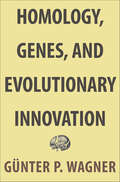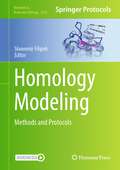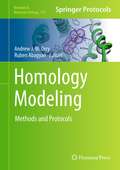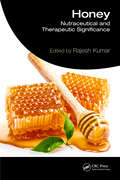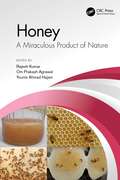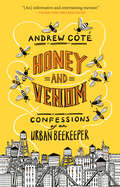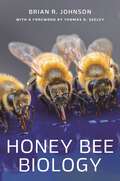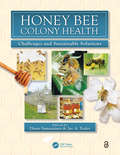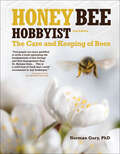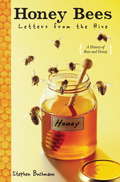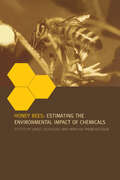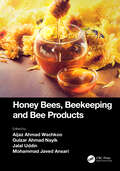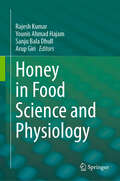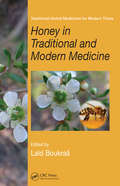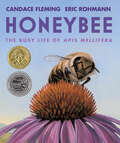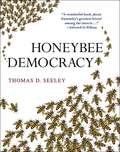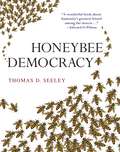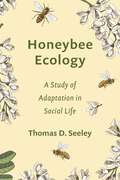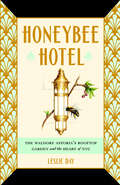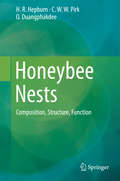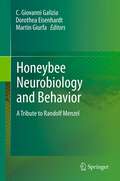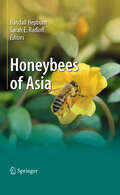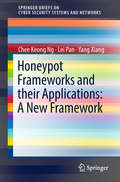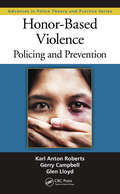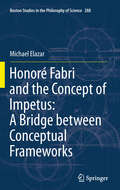- Table View
- List View
Homology, Genes, and Evolutionary Innovation
by Günter P. WagnerA major synthesis of homology, written by a top researcher in the fieldHomology—a similar trait shared by different species and derived from common ancestry, such as a seal's fin and a bird’s wing—is one of the most fundamental yet challenging concepts in evolutionary biology. This groundbreaking book provides the first mechanistically based theory of what homology is and how it arises in evolution.Günter Wagner, one of the preeminent researchers in the field, argues that homology, or character identity, can be explained through the historical continuity of character identity networks—that is, the gene regulatory networks that enable differential gene expression. He shows how character identity is independent of the form and function of the character itself because the same network can activate different effector genes and thus control the development of different shapes, sizes, and qualities of the character. Demonstrating how this theoretical model can provide a foundation for understanding the evolutionary origin of novel characters, Wagner applies it to the origin and evolution of specific systems, such as cell types; skin, hair, and feathers; limbs and digits; and flowers.The first major synthesis of homology to be published in decades, Homology, Genes, and Evolutionary Innovation reveals how a mechanistically based theory can serve as a unifying concept for any branch of science concerned with the structure and development of organisms, and how it can help explain major transitions in evolution and broad patterns of biological diversity.
Homology Modeling: Methods and Protocols (Methods in Molecular Biology #2627)
by Sławomir FilipekThis detailed volume provides state-of-the-art methodologies and reviews of important topics in the field of homology modeling. From homology modeling in the twilight zone and improving accuracy through sequence space analysis to approaches to construct multi-protein complex models, the book explores a wide variety of uses and applications of this valuable technique. Written for the highly successful Methods in Molecular Biology series, the chapters include introductions to their respective topics, lists of the necessary programs, webservers, and databases, step-by-step and readily reproducible protocols, as well as tips on troubleshooting and avoiding known pitfalls. Authoritative and practical, Homology Modeling: Methods and Protocols serves as an ideal guide to recent homology modeling procedures, assumptions made, and model quality assessment that will illuminate the black box of homology modeling for novice readers and broaden the knowledge of this methodology for professionals.
Homology Modeling
by Andrew J. Orry Ruben AbagyanKnowledge about protein tertiary structure can guide experiments, assist in the understanding of structure-function relationships, and aid the design of new therapeutics for disease. Homology modeling is an in silico method that predicts the tertiary structure of an amino acid sequence based on a homologous experimentally determined structure. In, Homology Modelling: Methods and Protocols experts in the field describe each homology modeling step from first principles, provide case studies for challenging modeling targets and describe methods for the prediction of how other molecules such as drugs can interact with the protein. Written in the highly successful Methods in Molecular BiologyTM series format, the chapters include the kind of detailed description and implementation advice that is crucial for getting optimal results in the laboratory. Thorough and intuitive, Homology Modelling: Methods and Protocols guides scientists in the available homology modeling methods.
Honey: Nutraceutical and Therapeutic Significance
by Rajesh KumarThe book entitled Honey: Nutraceutical and Therapeutic Significance contains comprehensive information on honey with regard to its cosmeceutical, nutritional, and pharmacological significance.This book volume contains a total of 12 chapters related to different aspects of honey contributed by experts in the field, providing enormous knowledge about the nutraceutical and the role of different therapeutic strategies across the globe. Each chapter has the latest references and citations so that readers may get the latest knowledge in the field.This book volume shall offer the readers state-of-the-art records on the proposed topic and established research in the area. Each chapter shall integrate semantic and pragmatic facts about honey and its connection with animal physiology. Emphasis shall be placed on exploring and correlating all possible physiological disorders/diseases that can be controlled/or cured using honey. This book shall benefit scholars, students, and professionals especially those working in the areas of food science/industry, taste physiology, pharmacology, folk medicine, and Ayurveda. With a compelling blend of scientific insights and practical applications, this book serves as the definitive guide to unleashing nature's power for health and healing.
Honey: A Miraculous Product of Nature
by Rajesh Kumar Om Prakash Agrawal Younis Ahmad HajamHoney is a supersaturated solution of sugar made by bees. Honeybees collect a liquid secretion from flowers, called nectar, and take this back to their hives. It is an appreciated natural gift to humanity derived entirely from honeybees. Honey is the by-product of nectar collected by bees from the flowers, with some digestive enzymes produced by the honeybees themselves. Honey: A Miraculous Product of Nature summarizes the current status of honey, it’s uses and related aspects. This illustrated volume describes use of honey in traditional medicines, i.e. Ayurveda, Siddha, and Unani by acting as a preservative and nourishing agent. Also, other properties like digestibility, palatability, deliciousness, refreshing, thirst quencher, stomachic, anti-obtrusive, expectorant, anti-oxidative, anti-tussive and blood purifier are explained in beautiful manner. The role of honey in improving eyesight, strengthens gums and teeth and it’s use in jaundice, spleen enlargement, sore throat, chest diseases, sexual debility, renal and cystic calculi, intestinal worms, heart diseases and leprosy is very well described. The compiled knowledge from range of bee scientists, Honey: A Miraculous Product of Nature aims to provide broad knowledge on honey to the researchers, apiculturists and students to continue their work on honey and honeybees.
Honey and Venom: Confessions of an Urban Beekeeper
by Andrew CotéA year in the life of New York City&’s premier beekeeper, who chronicles his adventures and the quirky personalities he encounters while spreading his infinite knowledge of and passion for the remarkable honey bee. &“Coté&’s charming and poignant essay collection delivers the entertainment and smarts required to make real change in how we look at our planet—and ourselves.&”—Andrew ZimmernConsidered an &“industry legend&” by The New York Times, Andrew Coté has one of the most intriguing, challenging, and unique jobs in New York City—maintaining millions of honey bees atop some of the city&’s most iconic buildings. His apiaries have crowned the Waldorf Astoria and the Museum of Modern Art; reside on the North Lawn of the United Nations; reign above stores, hotels, restaurants, schools, churches, and synagogues; and are situated in community gardens, and even cemeteries, throughout the five boroughs. In this debut collection, Coté takes readers with him on his daily apiary adventures over the course of a year, in the city and across the globe. Here, among his many duties, he is called to capture swarms that have clustered on fire hydrants, air-conditioning units, or street-vendor umbrellas. Annually, he travels with his father to regions like remote Fijian islands, rural Uganda, Haiti, Ecuador, or Iraq with his organization, Bees Without Borders, where he teaches beekeepers how to increase their honey yield and income via beekeeping endeavors. Written with Coté&’s trademark humor, acumen, and a healthy dose of charm, Honey and Venom illuminates the obscure culture of New York City &“beeks&” and the biology of the bees themselves, from the humble drone to the fittingly named worker to the queen herself—who is more a slave than a monarch. The hive world, Coté reveals, is full of strivers and slackers, givers and takers, and even some insect promiscuity—startlingly similar to the prickly human variety. For Coté, a fourth-generation beekeeper, this is a family tradition, and this personal significance pervades his celebration of the romance and mystery of bees, their honey, and the beekeepers whose lives revolve around these most magical creatures.
Honey Bee Biology
by Brian R. JohnsonThe most comprehensive and up-to-date general reference book on honey bee biologyHoney bees are marvelously charismatic organisms with a long history of interaction with humans. They are vital to agriculture and serve as a model system for many basic questions in biology. This authoritative book provides an essential overview of honey bee biology, bringing established topics up to date while incorporating emerging areas of inquiry.Honey Bee Biology covers everything from molecular genetics, development, and physiology to neurobiology, behavior, and pollination biology. Placing special attention on the important role of bees as pollinators in agricultural ecosystems, it incorporates the latest findings on pesticides, parasites, and pathogens. This incisive and wide-ranging book also sheds vital light on the possible causes of colony collapse disorder and the devastating honey bee losses we are witnessing today.The study of honey bees has greatly expanded in recent years and there is more interest in these marvelous creatures than ever before. Honey Bee Biology is the first up-to-date general reference of its kind published in decades. It is a must-have resource for social insect biologists, scientifically savvy beekeepers, and any scientist interested in bees as a model system.
Honey Bee Colony Health: Challenges and Sustainable Solutions
by K. M. M. PrabhuThis book summarizes the current progress of bee researchers investigating the status of honey bees and possible reasons for their decline, providing a basis for establishing management methods that maintain colony health. Integrating discussion of Colony Collapse Disorder, the chapters provide information on the new microsporidian Nosema ceranae pathogens, the current status of the parasitic bee mites, updates on bee viruses, and the effects these problems are having on our important bee pollinators. The text also presents methods for diagnosing diseases and includes color illustrations and tables.
Honey Bee Hobbyist: The Care and Keeping of Bees
by Norman GaryA beginning apiarist’s comprehensive guide to keeping bees at home, from basic bee biology to the necessary tools, and more.Discover the secrets of successful hobby beekeeping with advice from a world-renowned honey bee expert. Dr. Norman Gary shares his extensive beekeeping expertise in this entertaining and authoritative guide. Honey Bee Hobbyist, 2nd Edition will help you decide whether hobby beekeeping is right for you and will introduce you to all of the equipment, tools, and protective clothing you’ll need to get started.Dr. Gary teaches you to understand bee behavior so you can relax and enjoy working with these amazing creatures. He takes you from assembling your new hive and stocking it with bees to managing a growing colony and harvesting your honey rewards. With fascinating color photographs, myth-busting insights, and never-before-published tips, this comprehensive handbook is your first step toward an enjoyable and rewarding lifelong hobby.Inside you’ll find:Detailed, practical instructions for hobby beekeepingBasics of honey bee anatomy, behavior, and reproductionHow to use a bee smoker and safely open a hiveHow to monitor hive conditions, prevent swarming, and deal with bee diseasesEffective sting-prevention strategiesFun ways to use your beekeeping hobby for entertainment and educationUpdated information on beekeeping in urban environments“Few people are more qualified to write a book explaining the fundamentals of bee biology and hive management than Dr. Norman Gary… This is a solid how-to book that I could recommend to any beekeeper.”—Dr. James E. Tew, The Ohio State University“As practical as it is engaging, Honey Bee Hobbyist by University of California, Davis, entomologist Norman Gary can help you decide if backyard beekeeping is for you and how to go about it. Learn all about these important pollinators, including the intricacies of bee reproduction and society, how to use surplus honey, and why most people shouldn’t be overly afraid of a bee’s sting.”—California Bountiful Magazine
Honey Bees: Letters from the Hive
by Stephen BuchmannA fascinating look at the story of bees, the many extraordinary and often unexpected ways they've enriched our lives from prehistoric times to today, and their importance in keeping the food chain thriving. This is the perfect book for honey lovers young and old, as well as a great choice for middle and high school book reports or for use as a resource for science projects. Readers will be taken into the hive-one part nursery, one part honey factory, one part queen's inner sanctum-then fly through backyard gardens, open fields, and deserts where wildflowers bloom. It's fascinating and delicious! For honey fanatics and all who have a sweet tooth, this book not only entertains and enlightens but also reminds us of the fragility of humanity's relationship with nature.
Honey Bees: Estimating the Environmental Impact of Chemicals
by James Devillers Minh-Hà Pham-DelègueHoney Bees: Estimating the Environmental Impact of Chemicals is an updated account of the different strategies for assessing the ecotoxicity of xenobiotics against these social insects, which play a key role in both ecology and agriculture. In addition to the classical acute laboratory test, semi-field cage tests and full field funnel tests, new te
Honey Bees, Beekeeping and Bee Products
by Aijaz Ahmad Wachkoo, Gulzar Ahmad Nayik, Jalal Uddin and Mohammad Javed AnsariHoney bees are social insects; they live together in large, well-organized family groups comprising three castes: queen (fertile female), workers (sterile females) and drones (males). During honey flow season, there is a considerable increase in the foraging activity of the workers and in the rate of egg laying by the queen. Sex determination in honey bees involves a multi-allelic locus, such that homozygotes develop as males and heterozygotes as females, whereas diet quality influences the caste determination in honey bees. Like all living organisms, honey bees can be infested with diseases and pests. Some of these are more deleterious to bee colonies than others, but it is important for the beekeeper to be able to recognize conditions that might be disease or pest-related and respond accordingly so as to improve the quality of honey and honey bee by-products.The best-known primary products of beekeeping are honey and wax, but pollen, propolis, royal jelly, venom, queens, bees and their larvae are also marketable primary bee products. The purpose of this book is to make available information on bee biology and beekeeping as well as to provide comprehensive information on manufacturing, processing and marketing of value-added bee products.This book has been designed as a useful tool for the many diverse professionals who characterize and market honey bee products, including beekeepers, non-beekeepers, small entrepreneurs, extension officers and those involved in small business development. This edited book will be the first of its kind to contain comprehensive information on both bees and bee products.Key Features: Contains comprehensive information on beekeeping. Discusses the recent advances in beekeeping. Sheds light on bee colony integration and organization. Contains brief information on honey bee products.
Honey in Food Science and Physiology
by Rajesh Kumar Sanju Bala Dhull Younis Ahmad Hajam Arup GiriThis book highlights the science underlying honey, which is central to an understanding of conventional medicine or ingredients of food used mostly in all societies and it is attracting increasing interest among food scientists and professionals worldwide. Honey, wax, propolis and royal jelly also have significant roles in various nutraceutical and pharmaceutical products and this book provides collective information and practical approaches regarding all characteristic features of honey and its applications as functional food and medicines. Not only does this book explain the comprehensive knowledge of honey and its medicinal properties based on current researched evidence, it also explores the contribution of honey in the food science and medicine industry as a significant part of nutraceuticals and functional food research. Written by leading scientists in the field, the book will be a valuable resource for students and researchers in the fields of food chemistry, nutritional science, taste physiology, and neuroscience, as well as for professionals in the food industry.
Honey in Traditional and Modern Medicine (Traditional Herbal Medicines for Modern Times)
by Laïd BoukraâThe use of honey can be traced back to the Stone Age. Evidence can be found for its nutritional and medicinal use beginning with prehistoric and ancient civilizations. Currently, there is a resurgence of scientific interest in natural medicinal products, such as honey, by researchers, the medical community, and even the general public. Honey in Tra
Honeybee: The Busy Life of Apis Mellifera
by Candace FlemingRobert F. Sibert Medal Winner Take to the sky with Apis, one honeybee, as she embarks on her journey through life!An Orbis Pictus Honor BookSelected for the Texas Bluebonnnet Master ListFinalist for the AAAS/Subaru SB&F Prize for Excellence in Science Books A tiny honeybee emerges through the wax cap of her cell. Driven to protect and take care of her hive, she cleans the nursery and feeds the larvae and the queen. But is she strong enough to fly? Not yet! Apis builds wax comb to store honey, and transfers pollen from other bees into the storage. She defends the hive from invaders. And finally, she begins her new life as an adventurer. The confining walls of the hive fall away as Apis takes to the air, finally free, in a brilliant double-gatefold illustration where the clear blue sky is full of promise-- and the wings of dozens of honeybees, heading out in search of nectar to bring back to the hive. Eric Rohmann's exquisitely detailed illustrations bring the great outdoors into your hands in this poetically written tribute to the hardworking honeybee. Award-winning author Candace Fleming describes the life cycle of the honeybee in accessible, beautiful language. Similar in form and concept to the Sibert and Orbis Pictus award book Giant Squid, Honeybee also features a stunning gatefold and an essay on the plight of honeybees.Cook Prize Honor BookA Kids' Book Choice Award FinalistAn American Library Association Notable Children&’s BookA New York Public Library Best Book of the YearNamed a Best Book of the Year by Kirkus Reviews, NPR, Shelf Awareness, School Library Journal, Publishers Weekly and more!A Horn Book Fanfare Best Book of the YearA Bank Street Best Children's Book of the Year!A Bulletin of the Center for Children's Books Blue Ribbon BookA Booklist Editor's ChoiceNamed to the Texas Topaz Reading ListA Junior Library Guild Gold Standard Selection
Honeybee Democracy
by Thomas D. SeeleyHoneybees make decisions collectively--and democratically. Every year, faced with the life-or-death problem of choosing and traveling to a new home, honeybees stake everything on a process that includes collective fact-finding, vigorous debate, and consensus building. In fact, as world-renowned animal behaviorist Thomas Seeley reveals, these incredible insects have much to teach us when it comes to collective wisdom and effective decision making. A remarkable and richly illustrated account of scientific discovery, Honeybee Democracy brings together, for the first time, decades of Seeley's pioneering research to tell the amazing story of house hunting and democratic debate among the honeybees. In the late spring and early summer, as a bee colony becomes overcrowded, a third of the hive stays behind and rears a new queen, while a swarm of thousands departs with the old queen to produce a daughter colony. Seeley describes how these bees evaluate potential nest sites, advertise their discoveries to one another, engage in open deliberation, choose a final site, and navigate together--as a swirling cloud of bees--to their new home. Seeley investigates how evolution has honed the decision-making methods of honeybees over millions of years, and he considers similarities between the ways that bee swarms and primate brains process information. He concludes that what works well for bees can also work well for people: any decision-making group should consist of individuals with shared interests and mutual respect, a leader's influence should be minimized, debate should be relied upon, diverse solutions should be sought, and the majority should be counted on for a dependable resolution. An impressive exploration of animal behavior, Honeybee Democracy shows that decision-making groups, whether honeybee or human, can be smarter than even the smartest individuals in them.
Honeybee Democracy
by Thomas D. SeeleyHow honeybees make collective decisions—and what we can learn from this amazing democratic processHoneybees make decisions collectively—and democratically. Every year, faced with the life-or-death problem of choosing and traveling to a new home, honeybees stake everything on a process that includes collective fact-finding, vigorous debate, and consensus building. In fact, as world-renowned animal behaviorist Thomas Seeley reveals, these incredible insects have much to teach us when it comes to collective wisdom and effective decision making. A remarkable and richly illustrated account of scientific discovery, Honeybee Democracy brings together, for the first time, decades of Seeley's pioneering research to tell the amazing story of house hunting and democratic debate among the honeybees.In the late spring and early summer, as a bee colony becomes overcrowded, a third of the hive stays behind and rears a new queen, while a swarm of thousands departs with the old queen to produce a daughter colony. Seeley describes how these bees evaluate potential nest sites, advertise their discoveries to one another, engage in open deliberation, choose a final site, and navigate together—as a swirling cloud of bees—to their new home. Seeley investigates how evolution has honed the decision-making methods of honeybees over millions of years, and he considers similarities between the ways that bee swarms and primate brains process information. He concludes that what works well for bees can also work well for people: any decision-making group should consist of individuals with shared interests and mutual respect, a leader's influence should be minimized, debate should be relied upon, diverse solutions should be sought, and the majority should be counted on for a dependable resolution.An impressive exploration of animal behavior, Honeybee Democracy shows that decision-making groups, whether honeybee or human, can be smarter than even the smartest individuals in them.
Honeybee Ecology: A Study of Adaptation in Social Life (Monographs in Behavior and Ecology)
by Thomas D. SeeleyFrom the acclaimed author of Honeybee Democracy, a classic account of the ecological factors that shape the social lives of honeybeesFor many years, research on honeybee social life dealt primarily with the physiological processes underlying the social system of the bee rather than the ecological factors that have shaped its societies. Thomas Seeley&’s landmark book unites the two approaches, emphasizing ecological studies of honeybee social behavior while also offering fresh perspectives on honeybee behavior and communication. It covers a broad range of topics, from adaptiveness of worker sterility and the economics of nest construction to information-center foraging, individual versus colony level selection, sex ratio evolution, colonial thermoregulation, evolution of colony defense, and adaptive radiation in colony design. Honeybee Ecology presents honeybees as a model system for investigating advanced social life among insects from an evolutionary perspective.
Honeybee Hotel: The Waldorf Astoria's Rooftop Garden and the Heart of NYC
by Leslie DayThe fascinating story of the urban honeybee garden on the roof of the legendary Waldorf Astoria hotel.The tale of Honeybee Hotel begins over one hundred years ago, with the Astor family and the birth of the iconic Manhattan landmark, the magnificent Waldorf Astoria. In those early days the posh art deco masterpiece had its own rooftop garden for guests to enjoy. Fast-forward to the turn of the twenty-first century, and we meet executive chef David Garcelon, the creative genius behind the idea of restoring the celebrated rooftop garden. His vision included six hives containing some 300,000 honeybees, which would provide a unique flavor for his restaurant’s culinary masterpieces. Yet Garcelon’s dream was much grander than simply creating a private chefs’ garden: he wanted the honeybee garden to serve as a bond among people. Soon the staff of the hotel, the guests, local horticulturists, and beekeeping experts formed a community around the bees and the garden, which not only raised vegetables, herbs, and honey to be served in the hotel but also provided healthy food to the homeless shelter across the street at St. Bartholomew’s Church. Through her meticulous research and interviews with culinary glitterati, entomologists, horticulturists, and urban beekeepers, Leslie Day leads us on a unique insider’s tour of this little-known aspect of the natural world of New York City. She familiarizes us with the history of the architectural and cultural gem that is the Waldorf and introduces us to the lives of Chef Garcelon and New York City’s master beekeeper, Andrew Coté.Day, an urban naturalist and incurable New Yorker, tells us of the garden’s development, shares delectable honey-based recipes from the hotel’s chefs and mixologist, and relates the fate of the hotel in the wake of the Waldorf’s change of ownership. During our journey, we learn quite a bit about apiaries, as well as insect and flower biology, through the lives of the bees that travel freely around the city in search of nectar, pollen, and resin. This absorbing narrative unwraps the heart within the glamour of one of the world’s most beloved cities, while assuring us that nature can thrive in the ultimate urban environment when its denizens care enough to foster that connection.
Honeybee Nests
by H. R. Hepburn C.W.W. Pirk O. DuangphakdeeThis work, a sequel to Honeybees and Wax published nearly 30 years ago, starts with a brief introduction and discussion of nesting sites, their spaces and densities, self-organization of nest contents, and interspecific utilization of beeswax. The following chapters cover communication by vibrations and scents and wax secretion, and discuss the queen in relation to the combs. Discussions on completed nests include the significance of brood, the roles of pollen and nectar flow, and comb-building, and are followed by a triad of related chapters on the construction of cells and combs and their energetic costs. An in-depth examination of the conversion of wax scales into combs, the material properties of scale and comb waxes, and the wax gland complex are presented. The next chapters are devoted to a comprehensive analysis of the literature on the chemistry and synthesis of beeswax, and, finally, the material properties of honeybee silk are highlighted.
Honeybee Neurobiology and Behavior
by Dorothea Eisenhardt Martin Giurfa C. Giovanni GaliziaThe book is a sequel of a similar book, edited by Randolf Menzel and Alison Mercer, "Neurobiology and Behavior of Honeybees", published in 1987. It is a "Festschrift" for the 70th birthday of Randolf Menzel, who devoted his life to the topic of the book. The book will include an open commentary for each section written by Randolf Menzel, and discussed with the authors. The written contributions take their inspiration from a symposium on the topic, with all the authors, that was held in Berlin in summer 2010
Honeybees of Asia
by H. Randall Hepburn Sarah E. RadloffA multi-authored work on the basic biology of Asian honeybees, written by expert specialists in the field, this book highlights phylogeny, classification, mitochondrial and nuclear DNA, biogeography, genetics, physiology, pheromones, nesting, self-assembly processes, swarming, migration and absconding, reproduction, ecology, foraging and flight, dance languages, pollination, diseases/pests, colony defensiveness and natural enemies, honeybee mites, and interspecific interactions. Comprehensively covering the widely dispersed literature published in European as well as Asian-language journals and books, "Honeybees of Asia" provides an essential foundation for future research.
Honeypot Frameworks and Their Applications: A New Framework (SpringerBriefs on Cyber Security Systems and Networks)
by Yang Xiang Lei Pan Chee Keong NgThis book presents the latest research on honeypots and their applications. After introducing readers to the basic concepts of honeypots and common types, it reviews various honeypot frameworks such as web-server-based, client-based, shadow and artificially intelligent honeypots. In addition, it offers extensive information on the contribution of honeypots in some of the most popular malware research area such as DDoS, Worm, APT, forensics and Bot attacks. The book subsequently tackles the issue of honeypot countermeasures, shows many of the tricks often used by hackers to discover honeypots, and proposes a counter-countermeasure to help conceal them. It then puts forward a new framework that integrates various novel concepts, and which can feasibly be used for the detection of potential ransomware and bitcoin. As such, the book provides non-experts with a concise guide to honeypots, and will also benefit practitioners working on security systems.
Honor-Based Violence: Policing and Prevention (Advances in Police Theory and Practice)
by Karl Anton Roberts Gerry Campbell Glen LloydHonor-based violence (HBV) is a crime committed to protect or defend the honor of a family and/or a community. It is usually triggered by the victim‘s behavior, which the family and/or community regards as causing offense or dishonor. HBV has existed for thousands of years but has only very recently become a focus of law enforcement, policy makers,
Honoré Fabri and the Concept of Impetus: A Bridge between Conceptual Frameworks
by Michael ElazarThis book discusses the impetus-based physics of the Jesuit natural philosopher and mathematician Honoré Fabri (1608-1688), a senior representative of Jesuit scientists during the period between Galileo's death (1642) and Newton's Principia (1687). It shows how Fabri, while remaining loyal to a general Aristotelian outlook, managed to reinterpret the old concept of "impetus" in such a way as to assimilate into his physics building blocks of modern science, like Galileo's law of fall and Descartes' principle of inertia. This account of Fabri's theory is a novel one, since his physics is commonly considered as a dogmatic rejection of the New Science, not essentially different from the medieval impetus theory. This book shows how New Science principles were taught in Jesuit Colleges in the 1640s, thus depicting the sophisticated manner in which new ideas were settling within the lion's den of Catholic education.
